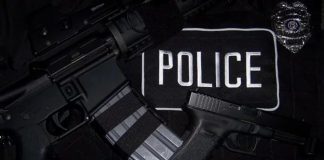In today’s litigious society no law enforcement agency can afford to overlook the need for administrative and training regulations for any weapon, or potential weapon, that police officers carry. Most police officers today are carrying one or more knives on their person, in and out of uniform, on and off duty. Police officers are carrying a knife because it is such a wonderfully versatile tool: it can be used as a rescue device to extract people stuck in vehicles; it can be a utility blade used to cut barricade tape; and for officers who wear glasses that sharp tipped knife is often used to tighten those tiny screws that hold on the eyeglass arms. It is also a potential tool for the delivery of lethal force and as such its use is a waiting target for a liability suit. Law Enforcement agencies in general expect lawsuits and don’t fear them as a matter of doing business. However, if the agency is sued for an officer’s use of a departmentally recognized lethal force tool for which the department has no regulations or training foundation it is realistic to assume that the agency will have a difficult time defending itself in court.
The methods by which agencies can minimize their liability from officers carrying and using knives vary from prohibiting the carry of a knife to recognizing its potential and fully training their officers in every potential use. Between those two extremes lies a vast area of administrative quagmire that the average agency has to swim through to find an acceptable way of dealing with the knife as a law enforcement tool.
As difficult as those extremes might be to conceive as reality, they do exist. The Maryland State Police regulations specify that a “rescue tool” will be issued to each officer. The section about Rescue Tools contains the following wording: “a device equipped with a belt clip and intended use of this tool is for emergency rescue situations, i.e. cutting seatbelts at accident scenes or freeing victims that may be entangled in such an instance by a foreign object.” Further the regulations go on to prohibit the use of the rescue tool as a defensive or offensive weapon. Following that the regulations go on to list a few more ways that the Rescue Tool cannot be used.
The Maryland State Police Rescue Tool is manufactured by Beretta. It looks an awful lot like an air-weight Beretta folding lock-blade knife. In issuing such a tool to the troopers the Maryland State Police provide them with a valuable tool. In prohibiting those troopers from using it as a weapon they create a problematic situation: If one of those troopers needs to use that “rescue tool” as a defensive weapon and, as a matter of last resort, does use it then the trooper has violated the regulations. Using a departmentally issued tool to defend yourself, but only being able to do so if you violate departmental regulations, tends to leave a negative outlook in your mind.
The Northglenn Police Department in Colorado has taken a decidedly different approach. The Northglenn PD General Orders, in the section on Use of Force, specifically addresses edged weapons. The use of an edged weapon should be considered as a defensive weapon and as an additional tool in a Level V situation when no other adequate instrument may be available. The Northglenn PD quantifies the varying levels of threat from one through five with Level V (level five) being deadly force. To back up this potential use of an edged weapon for lethal force the Northglenn General Orders also delineate what type of edged weapon an officer is permitted to carry and mandates that each officer “shall be certified in Law Enforcement Edged Weapons Training and receive annual defensive edged-weapons training.” Prior to participating in the training a departmental Law Enforcement Edged Weapons Certified Instructor must inspect the weapon, and the officer, upon completing the training is certified and registered in Law Enforcement Edged Weapons use.
If you examine the policy as it’s written, the Northglenn PD has covered itself pretty well. Not only does it dictate what types of edged weapons its officers can carry, it mandates that properly certified instructional personnel shall inspect any knife that officers want to carry and that the officers must be properly trained prior to carrying the weapon. Such a training program would have to be properly structured and documented with Use of Force addressed in much the same manner, as it would be in any firearms training. If the trained and certified police officer, carrying a knife which meets the departmental guidelines and which has been inspected by a certified staff instructor, uses that knife as a defensive weapon “when no other adequate instrument may be available” then the officer and the agency are protected pretty well from liability issues. All of this assumes that the use of deadly force is justified and that the officer used it as he was trained.
The examples set forth above show two different approaches to efforts departments make to control edged weapon carry and use by their officers and how the agencies attempt to minimize the liability they might be exposed to. Reading these examples and recognizing the extremely different approaches, one might ask, “What should a policy on edged weapons cover?”
Recognizing that the use of a knife – be it fixed or folding blade, straight or serrated-edge, short or long blade represents a potential use of force situation. Where many administrators get concerned is that if they label that knife as a “weapon” then they can’t authorize its use as a utility tool. After all, you wouldn’t use your handgun to extract someone from a burning car would you? How can any agency authorize the use of a weapon for other use than what is represented on the Use of Force Continuum? Labels cause confusion. “Lawyer speak” scares those who have to write the policies that will protect their agency and their fellow officers. Let’s try to simplify it some.
To start with a good knife policy has to be kept in mind when the department’s Use of Force policy is developed or updated. A good Use of Force policy today permits the officer to use anything available to deliver lethal force given the appropriate circumstances. A “Weapon of opportunity” is anything that officer can grab when his sidearm malfunctions or isn’t available. If the Use of Force policy prohibits the use of other tools such as batons, vehicles, flashlights, knives, etc. to deliver lethal force, then the officer is back in that trick-bag: I can defend myself but only by breaking the rules. While “normal” use of the baton, patrol car and flashlight don’t include use as a lethal force option, under certain circumstances any of them can be used to deliver defensive lethal force and the option to use them as such should be covered in the Use of Force policy.
That said, and assuming that the department’s Use of Force policy allows for knives to be used as circumstances dictate, the Knife Policy must be built to address the knife as more than a weapon. Calling the knife a “rescue tool” is perfectly acceptable and serves to present the carry and use of a knife in a more community-friendly image. Some companies manufacture knives that are specifically designed for rescue usage, but the blades would be great for defensive lethal force as well. The example that comes to mind is Spyderco’s Rescue blade.
Whatever label the department chooses, unless it’s going to issue knives to all officers and limit them to carrying only the issued blade, the policy must dictate what types of knives are authorized for carry. This section of the policy should set limits on minimum and maximum blade lengths, identify acceptable blade material, proscribe acceptable types of locking mechanisms, and delineate other desired features i.e. side clip or lanyard hole. By detailing the characteristics of departmentally authorized knives the agency can protect itself from liability caused by officers carrying low-quality knives that are as much a threat to the officers as they are to the suspects when used. Most often this type of liability is going to be incurred when the untrained officer carrying a knife of poor-quality construction manages to close it on his own fingers. To insure compliance with this directive, the policy should mandate inspection by qualified staff personnel prior to an officer carrying the tool.
Once the type of knife authorized is described, how it can be carried must be addressed. Though it might be labeled as a rescue tool, it obviously cannot be carried into a secure area such as prisoner processing. Again, this is where the knife proves itself a unique item and has to be approached correctly. The Knife Policy should prohibit the storage of the knife in a patrol cruiser’s glove compartment or center console, and certainly it should never be stored on the sun-visor. The Knife Policy should dictate how the officer will carry the knife such as clipped in a pocket, in a sheath on the duty belt, or on a lanyard in a pocket. This section of the policy will largely be determined by the physical characteristics the department approves for knives.
The Knife Policy should mandate training in the proper carry, deployment, use of, defense against, and storage of the knife. This section should specify training standards such as number of hours and who may provide such training if the department doesn’t have the capability to do so. Such training should meet all of the same structural requirements as firearms training as to documentation, policy review, nomenclature, etc. as well as providing training in use of the knife as a utility tool. The liability suit can come as easily from an unintended nick delivered to a trapped driver in a burning vehicle as you cut his seatbelt as it can from the criminal you had to cut to save your life. To protect the agency equally from these potential situations the training should cover reasonably expected uses of the knife both as a utility tool and as a weapon. For carry regulation, the policy should state whether the knife must be carried concealed, on the duty belt, and how the regulation applies off duty. If required, the policy should state that the officer shall carry the blade off duty, recognized it as a lethal force tool just like the issued firearm.
Finally, the Knife Policy should dictate what documentation is required of the police officer should the knife be deployed and used. Such a reporting requirement could range from no paperwork for utility use such as cutting barricade tape, to an incident report for use as a rescue tool, to a Use of Force report if the knife is used as a lethal force option. The completion of the different types of paperwork, if not covered in other training, should be included in the training program for the knife.
In quick review the Knife Policy should:
- work cohesively with the department Use of Force policy
- characterize the knife as a utility or rescue tool
- permit the use of the knife as a lethal force option
- delineate characteristics of an acceptable duty knife
- delineate carry and storage methods for the knife
- dictate training mandates that cover all aspects of potential knife usage
- proscribe reporting procedures for knife deployment and use
By implementing a policy that covers all these items, a law enforcement agency can minimize the liability it is exposed to as a result of its officers carrying and using edged weapons. Further, agency authorization for officers to carry and use edged weapons is often viewed as a supportive action by those same officers. In other words, it can be a morale booster if a proper edged weapons policy is created and implemented. No matter what type of policy your agency puts into effect, the bottom line is that officers carry and use knives. If your agency isn’t addressing that in regulation and training then it is unconditionally exposed to the liability resulting from an officer’s use of an edged weapon, no matter what that use might be.






